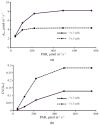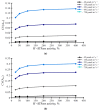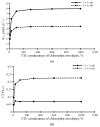Simulated Analysis of Influence of Changes in H+-ATPase Activity and Membrane CO2 Conductance on Parameters of Photosynthetic Assimilation in Leaves
- PMID: 36559546
- PMCID: PMC9783116
- DOI: 10.3390/plants11243435
Simulated Analysis of Influence of Changes in H+-ATPase Activity and Membrane CO2 Conductance on Parameters of Photosynthetic Assimilation in Leaves
Abstract
Photosynthesis is an important process in plants which influences their development and productivity. Many factors can control the efficiency of photosynthesis, including CO2 conductance of leaf mesophyll, which affects the CO2 availability for Rubisco. It is known that electrical stress signals can decrease this conductance, and the response is probably caused by inactivation of H+-ATPase in the plasma membrane. In the current work, we analyzed the influence of both CO2 conductance in the plasma membrane, and chloroplast envelopes and H+-ATPase activity on photosynthetic CO2 assimilation, using a two-dimensional mathematical model of photosynthesis in leaves. The model included a description of assimilation on the basis of the Farquhar-von Caemmerer-Berry model, ion transport through the plasma membrane, diffusion of CO2 in the apoplast, and transport of CO2 through the plasma membrane and chloroplast envelope. The model showed that the photosynthetic CO2 assimilation rate was mainly dependent on the plasma membrane and chloroplast envelope conductance; direct influence of the H+-ATPase activity (through changes in pH and CO2/HCO3- concentration ratio) on this rate was weak. In contrast, both changes in CO2 conductance of the plasma membrane and chloroplast envelopes and changes in the H+-ATPase activity influenced spatial heterogeneity of the CO2 assimilation on the leaf surface in the simulated two-dimensional system. These effects were also observed under simultaneous changes in the CO2 conductance of the plasma membrane and H+-ATPase activity. Qualitatively similar influence of changes in the CO2 conductance of the plasma membrane and chloroplast envelopes, and changes in the H+-ATPase activity on photosynthesis were shown for two different densities of stomata in the simulated leaf; however, lowering the density of stomata decreased the assimilation rate and increased the heterogeneity of assimilation. The results of the model analysis clarify the potential influence of H+-ATPase inactivation on photosynthesis, and can be the basis for development of new methods for remote sensing of the influence of electrical signals.
Keywords: H+-ATPase; chloroplast envelope CO2 conductance; electrical signals; photosynthetic CO2 assimilation; plasma membrane CO2 conductance; spatial heterogeneity; two-dimensional photosynthetic model.
Conflict of interest statement
The authors declare no conflict of interest. The funders had no role in the design of the study, the collection, analyses, or interpretation of data, the writing of the manuscript or in the decision to publish the results.
Figures






Similar articles
-
Development of Two-Dimensional Model of Photosynthesis in Plant Leaves and Analysis of Induction of Spatial Heterogeneity of CO2 Assimilation Rate under Action of Excess Light and Drought.Plants (Basel). 2022 Nov 29;11(23):3285. doi: 10.3390/plants11233285. Plants (Basel). 2022. PMID: 36501325 Free PMC article.
-
Changes in Activity of the Plasma Membrane H+-ATPase as a Link Between Formation of Electrical Signals and Induction of Photosynthetic Responses in Higher Plants.Biochemistry (Mosc). 2023 Oct;88(10):1488-1503. doi: 10.1134/S0006297923100061. Biochemistry (Mosc). 2023. PMID: 38105019 Review.
-
Surfing the Hyperbola Equations of the Steady-State Farquhar-von Caemmerer-Berry C3 Leaf Photosynthesis Model: What Can a Theoretical Analysis of Their Oblique Asymptotes and Transition Points Tell Us?Bull Math Biol. 2019 Dec 23;82(1):3. doi: 10.1007/s11538-019-00676-z. Bull Math Biol. 2019. PMID: 31919660 Free PMC article.
-
Role of mesophyll diffusion conductance in constraining potential photosynthetic productivity in the field.J Exp Bot. 2009;60(8):2249-70. doi: 10.1093/jxb/erp036. Epub 2009 Apr 23. J Exp Bot. 2009. PMID: 19395391 Review.
-
Modelling the relationship between CO2 assimilation and leaf anatomical properties in tomato leaves.Plant Sci. 2015 Sep;238:297-311. doi: 10.1016/j.plantsci.2015.06.022. Epub 2015 Jul 17. Plant Sci. 2015. PMID: 26259196
Cited by
-
Development of Modified Farquhar-von Caemmerer-Berry Model Describing Photodamage of Photosynthetic Electron Transport in C3 Plants under Different Temperatures.Plants (Basel). 2023 Sep 8;12(18):3211. doi: 10.3390/plants12183211. Plants (Basel). 2023. PMID: 37765375 Free PMC article.
-
Hyperpolarization electrical signals induced by local action of moderate heating influence photosynthetic light reactions in wheat plants.Front Plant Sci. 2023 Apr 5;14:1153731. doi: 10.3389/fpls.2023.1153731. eCollection 2023. Front Plant Sci. 2023. PMID: 37089652 Free PMC article.
-
Analysis of Electrome as a Tool for Plant Monitoring: Progress and Perspectives.Plants (Basel). 2025 May 16;14(10):1500. doi: 10.3390/plants14101500. Plants (Basel). 2025. PMID: 40431063 Free PMC article. Review.
-
Spectral composition of LED light differentially affects biomass, photosynthesis, nutrient profile, and foliar nitrate accumulation of lettuce grown under various replacement methods of nutrient solution.Food Sci Nutr. 2023 Oct 10;11(12):8143-8162. doi: 10.1002/fsn3.3735. eCollection 2023 Dec. Food Sci Nutr. 2023. PMID: 38107131 Free PMC article.
References
-
- Von Caemmerer S., Farquhar G., Berry J. Biochemical model of C3 photosynthesis. In: Laisk A., Nedbal L., Govindjee, editors. Photosynthesis In Silico: Advances in Photosynthesis and Respiration. Volume 29. Springer; Dordrecht, The Netherlands: 2009. pp. 209–230.
Grants and funding
LinkOut - more resources
Full Text Sources

